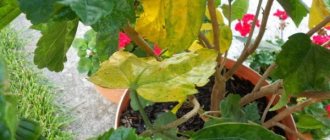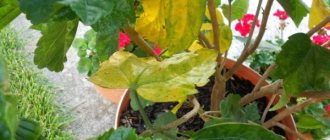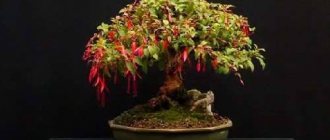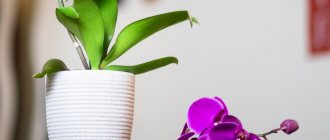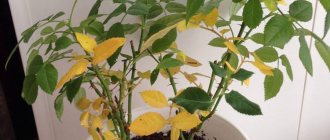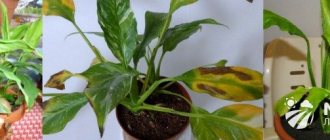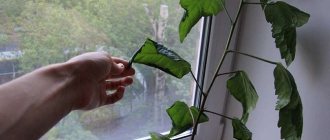What are hibiscus diseases?
Definition
Hibiscus disease is various deviations in its growth and development, as well as a violation of the decorative appearance. Absolutely different parts of the plant can be affected, depending on the type of disease and the cause of its development.
Types of ailments
There are several diseases that affect different parts of the flower:
Rust. With this disease, the plant's shoots become bent and thickened. With the onset of spring, orange dust forms on the stems at the blossoming buds and at the root collar.- Powdery mildew . This is a fungal disease in which a powdery coating forms on young leaves, shoots and buds. In addition, the affected parts of the flower thicken and become distorted.
- , dark brown spots form on the leaves , which take on different sizes. The leaf blade turns brown and the foliage falls off.
- Bacterial cancer . Growths of different sizes form on the root collar and roots of the Chinese rose. At first they are barely noticeable, but then their sizes reach several centimeters in diameter. The growths are distinguished by an uneven tuberculate surface. They are made of soft fabric. At first their color is white, and then brown.
Differences from pest damage
The main difference is that parasites on leaves or stems leave certain traces of their vital activity, for example, mucus, sticky coating. But diseases, as a rule, manifest themselves in the form of spotting on the leaves and rot of the stems. In addition, it is enough just to carefully examine the flower and understand whether there are any pests on it.
Why does the plant suffer from diseases?
Drying . The main reason for the drying out of the Chinese rose is the lack of modern watering. It is also the plant’s reaction to a change of location. The leaves will dry up on a frozen flower. You just need to give him time to come to his senses and warm up.- Withering . The main reason for the wilting of the tips of the leaves is a deficiency of phosphorus, nitrogen, and lack of complementary feeding of hibiscus. An increased temperature in the room and a decrease in humidity to low levels can affect the general wilting of the leaves and the entire flower.
- Curling of leaves . If a Chinese rose begins to curl its leaves into a tube, then this is a symptom of pest infestation. The most dangerous pests for hibiscus are aphids, whiteflies and spider mites.
- Falling off (you can find out why Chinese rose buds fall off and leaves fall off and what to do about it here). Falling leaves is a reaction to low humidity, lack of spraying, sudden changes in lighting, drafts and other types of stress for the rose.
- Yellowing of the crown . Yellowing of the leaf blade is caused by several reasons:
- pests;
- root diseases;
- leaf chlorosis;
- poor air humidification in the room.
Read about why Chinese rose leaves and buds turn yellow and fall off and what to do to treat it in our material.
- Lack of flowering . There are many reasons that affect the lack of flowering. The most important thing remains an excess of nitrogen fertilizing, especially when the plant looks healthy and is abundantly covered with leaves. The following reasons may also affect the lack of flowering:
- bad light;
- insufficient hydration;
- During wintering, the Chinese rose is in a room that is too warm.
Prevention
To prevent the development of recurrent disease, the following preventive measures must be taken:
- Temperatures should not go beyond the normal range - 18-22 degrees Celsius. Drying and waterlogging are unacceptable.
- Timely treatment against pests. They lead to leaf deformation and the development of diseases. For processing use Peretrum, Actofit.
- It is best to use mineral complex fertilizers to regularly apply nutritional compounds.
- The air in the room should be moderately humid, but not dry.
- Temperature . Chinese rose is a heat-loving plant. In spring and summer, temperatures will be 25 degrees Celsius, and in winter – 15-20 degrees. If the winter temperature is below 10 degrees, the leaves will fall off. In summer, place the flower on the balcony, protecting it from rain and wind.
- Lighting . Hibiscus is a light-loving crop. Diffused light is important for him. If direct sunlight hits the flower in summer, this can lead to the development of a burn. Grow the plant on east or west windows.
- Watering . In spring and summer, Chinese roses need abundant watering. Use settled water at room temperature. Avoid overmoistening. In winter, watering is moderate. Before the next irrigation, wait until the soil is completely dry. Be sure to provide good drainage.
- Air humidity . In summer, hibiscus needs high humidity. It is useful for him to carry out frequent spraying. Just don’t let water get on the flowers, otherwise they may fall off. In winter, less moisture is required. But if there was central heating, then spraying should be carried out every other day.
- Feeding . From spring until autumn, add complex nutritional compositions intended for flowering indoor plants. Do this once every 2 weeks. Starting from August, reduce nitrogen-containing fertilizing.
- Trimming . Heavily prune your Chinese rose every spring. This will allow the bush to acquire a compact shape with a large number of buds. If the plant begins to stretch too much, then prune it during the growth period. Thanks to pruning, the flower can take the form of a bush or tree.
Read also: Violet winter evening photo
Caring for a houseplant at home
- Provide the flower with diffused light.
- Carry out periodic spraying.
- Keep the plant warm and avoid sudden temperature changes.
- Conduct transplantation on time.
- Provide abundant regular watering in spring and summer and monitor its moderation in winter.
The exotic, handsome hibiscus cannot be called very whimsical in its content . Following simple rules of care is useful not only for the plant, but also for its owner, as it helps to avoid the hassle of urgently eliminating defects and diseases.
Causes
The Chinese rose is undemanding and will tolerate shortcomings when caring for it, unless inattention to the plant develops into a permanent phenomenon. More often, for objective reasons, rose leaves turn yellow and fall off. It is important to understand what is happening and take action to eliminate weaknesses in care in order to prevent the flower from dying.
Let's look at the most common causes of yellowing and falling leaves.
Natural
In preparation for the dormant period, the leaves of the Chinese rose turn yellow and fall off. The flower sheds some of its leaves in winter; it needs rest after flowering and to recuperate for the future. The rose gets rid of yellowed old ones when many young leaves appear on the bush.
Old plants that are getting ready to die also shed their leaves. These are natural causes of leaf wilting.
Stress
Hibiscus does not like to be moved from place to place. Simply turning or moving to another room causes severe stress to the plant. Before adapting to new conditions, the flower sheds its yellowed leaves. A difficult test for a rose is transplanting it into a new pot. She gets sick for a long time because the roots are often damaged during transshipment. While new roots are restored and grow, the flower sheds its foliage.
Effect of moisture
Dried soil in a pot with a Chinese rose leads to the death of the roots and massive leaf loss. The cause is a cramped pot or insufficient moisture. The required amount of nutrition is not delivered to the leaves, they turn yellow and fall off. Find out the exact cause by the dried soil in the center of the flower pot. To do this, water the rose in the morning, and closer to night they look to see if the soil in the center of the container is dry. Dryness indicates that the flower is cramped in this container. In summer, the Chinese rose feels a lack of moisture even with constant watering in the morning and evening.
Excess moisture can adversely affect the flower. The hibiscus is withering. The soil in the pot becomes compacted and air does not enter there. Stagnant water appears, the soil becomes swampy, which leads to the emergence of bacteria and fungi. This is due to the large pot. The roots of the plant rot and die in this environment. Diseased roots do not supply enough nutrition for the normal existence of hibiscus. The leaves turn yellow and fall off.
Temperature
As a native of the tropics, the Chinese rose does not tolerate cold and drafts; it is kept away from air conditioners. When ventilating, the rose is closed from the air flow. The indoor flower is kept in an acceptable temperature environment of +18.30°C. In winter, when the rose is in a state of hibernation, the room temperature is maintained at +13.15 ° C, provided that there is additional lighting. In spring and until early autumn, the room is maintained at +17.23°C. Cooling to +10°C provokes yellowing and falling of leaves.
Illumination
Another reason why Chinese rose leaves turn yellow and fall off is improper lighting. As usual, they turn yellow on the side of the plant that is in the shade. However, hibiscus should not be exposed to direct sunlight. Excess sun will cause burns, which will cause the leaves to turn yellow and they will fall off.
Hibiscus still reacts to lack of light. Diffused lighting has a beneficial effect on the flower. And in winter, the lack of natural light is supplemented with the light of fluorescent lamps.
Chlorosis
Evidence of chlorosis disease in Chinese hibiscus is yellowing of the leaf plates, while the veins remain green. In addition, spots appear on the leaves. The reason for these phenomena is the increased acidity of the soil, which is provoked by tap water. Chlorosis does not affect the entire plant at once. More often, the young roots and tops of the rose become sick, and the yellow leaves fall off.
Mineral deficiency
It is important to notice in which part of the Chinese hibiscus the leaves turn yellow. A lack of nutrients is indicated if the upper leaves of a flower turn yellow. Leaves turn yellow if there is insufficient zinc, manganese, magnesium and iron. The increased content of chlorine and calcium in the water causes the lower leaves to fall off, and new ones to grow yellow. If there is not enough nitrogen or iron, the phenomenon repeats.
Fertilizers must be applied carefully, the main thing is not to exceed the norm. If there is not enough nitrogen, the leaf veins turn yellow, if there is potassium, the entire leaf turns yellow. The increased content of magnesium and potassium does not harm the development of hibiscus.
The content of nitrogen and phosphorus exceeding the norm leads to massive yellowing of the leaves.
Spider mite
The pest becomes active on the plant when the air in the room is dry. In addition to yellowing of the leaves, cobwebs and a whitish coating form on the flower. Traces of mites can be seen on the back of the leaves in the form of small dots. In order not to provoke the activation of mites, the air near the plant is moistened and vessels with water are placed nearby.
Read also: Wild cat with spots 5
Diseases and pests
When hibiscus is infected with viruses, the leaves not only turn yellow, but spots appear on them. To prevent the Chinese rose from dying, it is necessary to begin treatment immediately. If there are no errors in care and the presence of yellowed leaves, the fact of plant disease is excluded.
Chlorosis
This virus is the most common disease. With it, the leaf of the plant turns yellow, and the veins retain their natural color. Chlorosis is a consequence of soil with impaired acidity levels. The situation can be corrected by using a complex of mineral fertilizers and replanting the plant in fresh soil. Tip: to avoid disease, it is not recommended to water hibiscus with hard water. It contributes to the oxidation of the earth.
Spider mite
Yellow sheets may indicate the presence of spider mites; they can only be seen when using magnifying devices. Dry air is the basis why spider mites appear. To prevent its occurrence, use humidifiers and prevent it using insecticides a couple of times a year. To save a diseased hibiscus, it is recommended to wash the leaves with a soapy solution. Regular spraying with water reduces the likelihood of spider mites.
What to do?
In order for the hibiscus leaves not to turn yellow and fall off, and for the rose to live comfortably at home, it needs to be properly cared for all year round, monitor the health of the flower and protect it from pests.
Replacing a flower pot
A small pot does not allow the rose to grow and develop properly, so it is replaced with a large one, which is 2-3 cm wider in diameter than the previous one. The flower is replanted using the transshipment method so as not to harm the roots. The hibiscus is placed in a new pot with moist soil and drainage, watered only on the third day.
The formation of excess water in the pan indicates that the pot for the plant is too large. It is replaced with a smaller one so that the roots do not rot and the plant dies. Before transplanting a flower, inspect its root system, clear it of soil, remove rotten fragments, treat the roots with a fungicide solution and sprinkle the sections with Kornevin powder or crushed activated carbon. After transplantation, the flower is sprayed with Zircon or Epin.
Proper watering
For lush flowering of the Chinese rose and the development of beautiful and healthy foliage in the summer, the flower is watered abundantly. The main thing is not to overdo it; water the plant again after the top layer has dried by 2-3 cm. The soil should not be dry or wet, but constantly moist. In hot, windy weather, it is recommended to water the flower every day, or even 2 times a day, and also spray it with water.
In winter, the Chinese rose is dormant, but this does not mean that it does not need to be watered , you just need to increase the time between waterings. Heating dries out the air in the room during the cold season, so it is important to spray the flower and the air next to it, and place a container of water next to it. Dry air can cause illness.
Top dressing
The disease chlorosis occurs in plants due to watering with untreated and unsettled water. It is better to transplant the Chinese rose into new soil or feed it with complex fertilizers that contain magnesium but do not contain lime. Epsom salts or magnesium in chelated form are sometimes used. Iron chelate is added to the water used to water the flower in case of iron deficiency.
You need to feed the Chinese rose in the morning or after sunset on cloudy, cool days. From the beginning of spring until September, the flower is fed once a week, or fertilizer is applied more often, but in reduced doses. In winter, fertilizing is applied only to flowering plants and only once a month. Some gardeners use water with added sugar as a top dressing - half a teaspoon of sugar per glass of water.
Nitrogen fertilizers are fed to hibiscus with caution - oversaturation leads to burns. Brown spots appear on the leaves, which indicates that the plant is oversaturated with nitrogen. The leaves gradually die off and the flower dies. To save the rose, they give it a break from feeding. Water for two weeks with clean water without impurities. When the plant recovers, feed and add nitrogen in small doses, gradually increasing the concentration to an acceptable value.
Fighting spider mites
They begin to fight pests hastily, otherwise they will not be able to save the flower. If the parasite has not had time to seriously damage the leaves, then thoroughly wash the foliage and stems with soapy water. If the damage is serious, then the rose must be treated with insecticides. The leaves are sprayed on both sides. The following drugs are suitable for this: “Fitoverm”, “Aktofit”, “Fufan”, “Antiklesch”, “Aktellik”. Spraying is carried out once every 4-5 days, 4 times in a row.
In addition, vessels with water or air humidifiers are placed next to the flower. Spray the plants and the air around them with water 1-2 times a day. It is important to create moist air around the flowers. Ticks are afraid of moisture. They will die in humid air. The leaves will remain green and beautiful.
To combat mites, gardeners also use folk remedies. To do this, add 1 part dry red pepper to 2 parts water, cook for 1 hour, filter. Treat the hibiscus with soapy water, to which 10 g of the resulting solution with pepper is added.
Why do hibiscus buds fall off: what does it need for lush flowering
Hibiscus (Hibiscus rosasinensis) or Chinese rose, belonging to the Malvaceae family, has no relationship with roses. This perennial shrub plant originates from the Asian tropics. It is found in Africa, South America, and in Hawaii it is considered a national symbol. Many of its varieties have taken root in the south of Russia, Ukraine, the Far East, Transcaucasia and other regions.
Blooming hibiscus looks very impressive
Hibiscus has long been cultivated as a houseplant. Red, pink, salmon, yellow, white or two-three-color large flowers with protruding pistil and stamens bloom in July-September.
Each of them lives for several days, coming to life at dawn and falling off at sunset.
For abundant flowering, this hardy, fast-growing ornamental perennial needs certain conditions, otherwise the buds will fall off without ever blooming.
[adsp-pro-4]
Possible causes of bud drop
Beginning gardeners often make mistakes in flower care, then wondering why hibiscus buds fall off. Some of the most common mistakes are worth dwelling on.
Under unfavorable conditions (usually in winter), a houseplant can even shed its leaves, remaining dormant for up to three months. If you do not let the soil dry out and periodically loosen its top layer, then, after resting, the flower will produce new leaves and begin to grow.
Aphids or root rot
Aphids on a hibiscus bud
Often the buds fall off due to aphids sucking the juices from the plants. She loves to settle on young shoots and buds, moving from neighboring flowers. If a colony of parasites is detected, you need to wash the flower with soap and water; if this is not enough, then use special preparations. It is better to start with folk remedies - tobacco, garlic, ash, onions.
Pests usually migrate from plant to plant, so treatment is done on all indoor flowers at the same time.
Perhaps the flower is affected by root rot or other fungal infections. This happens in high humidity with insufficient lighting or when the plant is in a draft. The plant withers, the leaves become stained, turn yellow, the leaves and buds fall off, and the roots rot.
Sick plants are removed from the pot, rotten roots are trimmed, disinfected in a manganese solution or sprinkled with crushed activated carbon. Then they are transplanted into a new earthen substrate, removing the damaged leaves. Treatment with fungicides is used: Oksikhom, Fundazol and others.
Unsuitable temperature
In warm weather, temperatures up to +25 degrees are suitable for hibiscus. In winter, it should not fall below +10 degrees, otherwise the plant will shed its leaves.
The optimal temperature for planting flower buds is no higher than +17 degrees. Therefore, in the fall, it is advisable to move the flower to a cool room with good lighting. This stimulates flowering. In March, when the first leaves appear on the branches, it is returned to its usual place.
[adsp-pro-5]
Watering and lighting errors
This tropical plant is light-loving; it does not die in the shade, but it may drop its buds or not produce them at all.
The best place for hibiscus is a high stand located near a south or east window. In winter, the flower needs lighting.
A daylight dump is directed at it from a distance of half a meter, extending the daylight hours to 8 hours. Otherwise, the plant will not be able to bloom at the right time.
Drying out the soil causes the leaves and buds to drop
When caring for hibiscus, you should take into account the watering conditions: in spring and summer it is plentiful, and in winter - as needed. Use water at room temperature, separated in a wide-necked jar.
The shrub cannot tolerate drying out of the soil and sheds its leaves and buds. In hot weather, moisture in the pot is retained better if you sprinkle fine expanded clay on top or lay out moss . At this time, it is still useful to regularly spray the plant or place a humidifier nearby. In winter, a vessel with water is placed on or next to the radiator. Artificial hydration won't hurt either.
In warm weather, it is good to give the plant a warm shower. To prevent water from stagnating at the roots, it is better to cover the ground with film during the procedure.
When spraying hibiscus, you need to be careful not to get water on the buds and flowers.
Feeding and stress
To feed the shrubs, use universal fertilizers for indoor flowering plants with a minimum nitrogen content (“Ideal”, “Rainbow”). For leaves, foliar feeding with an infusion of onion peels is useful. They become larger and shiny. It is also a prevention against pest attacks.
In spring, nitrogenous fertilizers are preferred for plants; in summer, potassium-phosphorus fertilizers are preferred. Fertilizers are applied on cool days in the morning or evening twice a month after watering. In winter this is done half as often. At the same time, in winter, nitrogen substances are not added to the nutrient mixture.
Magnesium deficiency causes yellowing of foliage and dropping of buds
Tropical perennials need magnesium: due to a deficiency of the mineral, the leaves turn yellow. If the doses of fertilizers are not indicated, then they are dissolved at the rate of 1 g per liter of water. This schedule and choice of nutritional preparations prolongs flowering and helps better formation of flower buds.
Feeding of transplanted plants begins only a week after the procedure.
Stress is one of the serious reasons for the fall of unopened buds. The flower experiences this state during radical changes: change of habitat, draft, replanting, watering with cold water. Therefore, during flowering, you should not replant or move flower pots. You can only turn them periodically to avoid bending the bush.
Abrupt change in conditions of detention
Changing care conditions is extremely harmful for a flowering plant. Therefore, during this important period for him, it is better for caring gardeners not to go on vacation, entrusting the care of their pet to uninformed people.
[adsp-pro-6]
Soil quality
Hibiscus needs loose, breathable soil. A mixture of 2 parts garden soil and 1 part universal flower substrate is suitable for him. Ideally, the soil is composed of pine, leaf soil, humus, peat with a small addition of charcoal or activated carbon.
The bottom of the pot must be filled with drainage, which includes expanded clay or fragments of brick.
The acidity of the soil mixture should be close to neutral (from 5.5 to 7.8). If it is higher or lower than the maximum permissible values, then due to lack of nutrition, flowering may not occur.
How to help a plant: advice and recommendations from gardeners on proper care and maintenance
Following the recommendations of experienced gardeners will help preserve hibiscus buds and flowers
Hibiscus buds and flowers can be preserved by following these simple rules:
- It is best to choose the brightest room for the plant, but close the window with thick curtains in the heat of the day.
- In summer, it is good to take the plant out onto the balcony or into the garden, but avoid drafts.
- Before watering the flower, it is useful to loosen the soil so that it does not form a crust that prevents the enrichment of the roots with oxygen.
- To stimulate the formation of buds, in the fall the hibiscus is placed in a cool, slightly darkened room (creating conditions for rest), and in February it is transferred to a warm and bright room, gradually increasing its watering and fertilizing.
- Lightly sweetened water is considered a useful flower food: half a spoon per glass of warm water.
- When defrosting the refrigerator, it is good to use melted ice (at room temperature) to water your tropical bush. If there is an admixture of blood from meat in it, then this is also a good supplement.
- Spraying a weakened plant with immunostimulating and anti-stress drugs helps a weakened plant cope with long-term stress: Zircon, Fitosporin, Epin-Extra and others.
Treatments with solutions of red pepper or mustard help against pests
You can get rid of annoying insects using folk remedies.
- Red pepper powder, half diluted with water, boil for an hour, strain. After this, add a spoonful of the solution to a liter of soapy water and treat the plant.
- Boil a quarter cup of mustard powder for a quarter of an hour in a liter of water, and after cooling, dilute it twenty times with water. Used to treat flowers against aphids or scale insects.
To stimulate hibiscus flowering, it is necessary to prune the bush, because buds form only on young branches. Some tips for proper pruning:
- It is usually done before hibernation, but can be done before the start of the growing season, in February.
- Damaged and dry shoots are removed, and the rest are cut to a third of the length, leaving at least 3 buds.
- Branches with buds should not be touched.
You can stimulate late flowering of hibiscus (in autumn or even winter) by leaving it cool and dark until May, watering occasionally. In this case, pruning should be done at the end of spring, repeating it in mid-summer.
How to make hibiscus bloom? You will learn about this from the video clip. Enjoy watching!
Source: https://cveti-rasteniya.ru/pochemu-u-gibiskusa-opadayut-butony-v-chem-on-nuzhdaetsya-dlya-pyshnogo-cveteniya.html
Aftercare
The Chinese rose will freely grow new foliage after treatment and freedom from pests. To do this, you need to remove all dried branches and leaves. Every spring, a young plant needs to be replanted; it is done using the transshipment method, and each time the flower is transplanted into a more spacious pot, leaving room for roots to grow.
Hibiscus is transplanted into light and nutritious soil. It is desirable that it consist of leaf soil - 1 part, turf soil - 2 parts and humus soil - 1 part. In addition, coarse sand is added to the soil, and bone meal can be added. Drainage is placed at the bottom of the pot, which can consist of broken bricks, ceramic shards, crushed stone, gravel or expanded clay. The main condition is that drainage should not injure the roots.
To form a beautifully shaped bush, you will need to trim shoots that are too long. Old, dried out, damaged or weak shoots are removed. Sometimes the tips of the shoots of a young plant are pinched to form a crown. The cut areas are powdered with charcoal. After pruning, the temperature in the room is reduced by 2°C. The soil should not be allowed to dry out, so the plant should be sprayed with water at room temperature every day.
An adult flower that is more than 3-4 years old is replanted every 3-4 years. Every spring, add a small layer of new soil to the pot on top of the old soil.
What to do if the flower is completely dry?
You can try to bring a dried plant back to life by taking the following measures::
- Completely remove all dried leaves.
- Trim the trunk as much as possible; if there is a small piece of undried stem left, cut it to its level.
- Replant the plant using the transshipment method.
- After moving the hibiscus to a new container, moisten the soil.
- Spray the plant with Epin.
- Cover the planting with a bag, thus creating a mini-greenhouse.
- The bag must be periodically removed for repeated treatments with a growth stimulator, and then returned to its place.
- In such conditions, hibiscus should be kept for at least two weeks. The success of the procedure will be indicated by the appearance of young shoots.
Preventive measures
To ensure that the leaves of the Chinese rose always remain green and healthy, the following conditions are observed:
- water not too often, but regularly, do not allow the soil to dry out;
- do not leave in direct sunlight, but put it in partial shade;
- feed once a week until September, and then once a month;
- water less frequently in autumn and winter, keep indoors at a temperature not lower than +15°C;
- sprayed with water every day all year round;
- transplanted in time into suitable soil with drainage;
- To prevent indoor plants from getting sunburn, place them in the sun for a short time and gradually increase their exposure;
- regularly inspected to identify pests;
- Regularly clean the area from dust using a warm shower, covering the ground.
To learn why the Chinese rose drops its buds, watch the following video.
